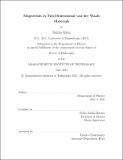Magnetism in Two-Dimensional van der Waals Materials
Author(s)
Klein, Dahlia
DownloadThesis PDF (31.21Mb)
Advisor
Jarillo-Herrero, Pablo
Terms of use
Metadata
Show full item recordAbstract
Layered van der Waals crystals are a rich proving ground for exploring electronic behavior confined to two dimensions. Since the discovery of graphene in 2004, a large family of crystals has been isolated in the ultrathin limit, hosting a range of different properties, including semiconductors, superconductors, and topological insulators. These few-atom-thick sheets can be restacked into endless combinations of artificial heterostructures with atomically sharp interfaces that can be thought of as fundamentally new quantum materials. For over a decade, however, magnetism was noticeably absent from van der Waals materials.
In this thesis, I present experiments on one of the first families of 2D magnets, the insulating chromium trihalides (CrX3), including CrI3 and CrCl3. These results were enabled by techniques developed to manipulate these air-sensitive few-layer crystals in an inert glovebox environment. I discuss magneto-optical experiments to measure and electrically control the magnetic ordering of ultrathin CrI3. I also present a new approach to probe the layer-dependent magnetic ordering by electron tunneling through van der Waals spin-filter magnetic tunnel junctions, where a few-layer crystal of CrX3 serves as the insulating tunnel barrier. Surprisingly, these magneto-optical and tunneling experiments reveal magnetic properties in ultrathin CrX3 differing from those of the bulk crystals. Using Raman spectroscopy, I connect these differences to changes in the lateral stacking arrangements between individual crystalline layers.
The techniques established to handle air-sensitive 2D magnets lay the groundwork for the discovery of novel magnetic phenomena in the many yet unexplored layered magnetic insulators. Moreover, the development of 2D magnetic tunnel junctions with large magnetoresistances and highly spin-polarized currents paves the way for integration in the spintronics community. Finally, the more complete understanding of the layer-dependent magnetism in ultrathin CrX3 unlocks the potential to carefully incorporate 2D magnets in a variety of van der Waals heterostructures for proximity magnetism effects and beyond.
Date issued
2021-06Department
Massachusetts Institute of Technology. Department of PhysicsPublisher
Massachusetts Institute of Technology